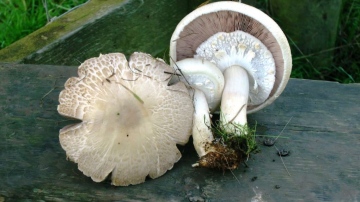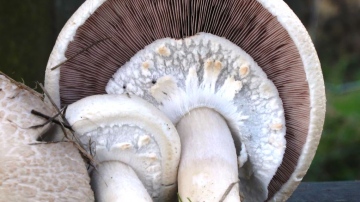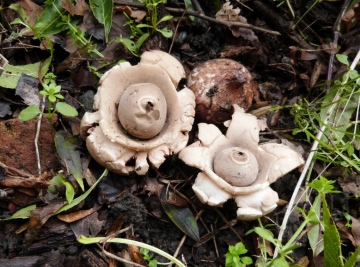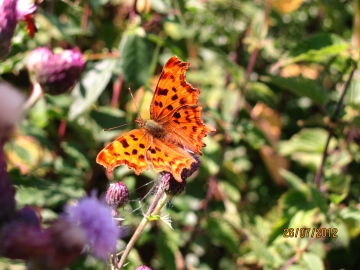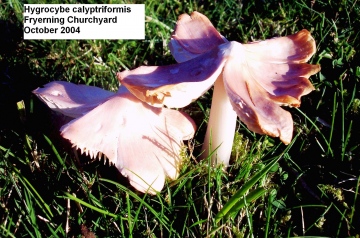Your Forum
The weblog below is for naturalists to use to report interesting sightings, ask questions, report on field meetings and generally post pictures and any information or questions generally relevant in some way to the wildlife and geology of Essex. You will need to register and be logged-on to post to the forum, and you need to upload pictures first, for use in posts. Find out more
|
Wed 13th November 2013 08:25 by Mary Smith Frost
We got up early this morning, to see frost on the lawn, on the car and on dead autumn leaves all over the place but looking much prettier than they did yesterday, with the white sparkles all over the edges and the veins. This is our first frost of the winter. Some say we are expecting a very cold winter, and it will be starting before November is out. Perhaps today's frost is the beginning.
And the frost marks the end of the fungus season, as they all curl up their toes when it is too cold, except for a very few frost-hardy species. But thank you, Graham, for extolling them this season. Mon 11th November 2013 17:37 by Graham Smith November 3rd - 9th
Two wildfowlers were shooting on Bridgemarsh Island when we completed the monthly WeBS count between North Fambridge and Althorne on Friday. My head tells me that I have no objection to wildfowling when it is carried out responsibly; and many wildfowling clubs do behave responsibly - insisting on the use of steel rather than lead shot, implementing bag limits, and improving habitats. The last may be done to improve their shooting but it also benefits wildlife as well. I dislike the use of baited flight ponds on farms, which are leased - more often than not - to clubs whose membership consists mostly of city types who roll up in their 4x4s, sit behind blinds in their posh new Barbours and slaughter gullible young Teal that circle round and round like plastic ducks on a fairground stall (I have heard of 30-40 being shot in a single evening) and then drive back to the City, with 'duck shooting' now on their CV's! But anyone who is prepared to sit for hours on the edge of the saltings during a freezing January dawn or dusk probably deserves a few birds for the pot - or so my head tells me - and you hope they main gain something more from the experience than the killing a few birds. And yet! Why is it then that whenever I hear a gun go off I swing round and scan the sky for a falling bird or the sight of a gundog running across the marsh and when neither is evident sigh with relief. He missed! At times too I am inwardly screaming at approaching birds - who are unaware of the guns below - to gain height; my relief almost audible when they do, my heart sinking when they do not and I see a bird fall. The truth is I cannot understand why anyone would want to kill anything unless they are hungry or defending their crops. Wildlife in general and birds in particular have brought great joy to my life and I have lost count of the number of times during the past fifty years when I have crawled on my belly up an Essex seawall in order to view the wildfowl in a creek beyond as they bathe and preen, squabble and socialize, and then to creep away again unseen. You feel privileged. And, heaven's above, there is but a morsel of flesh on a Teal - barely enough to cover a slice of toast; why on earth would you want to kill something that moments before was vibrant with life. Sad. So much for my head!
That apart, we had an enjoyable walk. Grassland fungi have been thin on the ground (so to speak) this autumn but today there were large numbers of Agaricus mushrooms fruiting along the seawall. At first sight they appeared to be the common Horse Mushroom A, arvense but the ones I took home for my tea keyed out as the much scarcer Agaricus fissuratus, a species that is very closely related to it but which DNA studies have shown to be separate. The distinctive orange-buff cap with radial cracks just beginning to appear can be clearly seen on the photographs; so too the large ring with yellow-brown cogs on the underside. Not so obvious is the bulbous base to the stem. Geoffrey Kibby, in his book on the Genus, states that it is most often found on woodland margins and in parkland but he also mentioned, at the recent Russell Wallace conference at Wat Tyler, that very few studies have been made of grazing marsh fungi, where these were growing. He would probably be fascinated to know that Wood Blewits also occur in the meadows at Blue House! Mon 4th November 2013 16:15 by Graham Smith October 27th-November 2nd
This forum is being under used, Such a shame. The so-called Storm of St Jude (the God of Lost Causes) came and went on October 28th. As usual a few unfortunates were in the wrong place at the wrong time but here at Ingatestone the effects were minimal: the electricity supply was cut off for about five hours and a few trees came down, blocking minor roads for a while. Oh yes, and one of my perspex greenhouse panels disappeared into the void, luckily - or so it would seem - without decapitating anyone when it descended. What is probably the greatest lost cause is that the media (including dear old Auntie) will one day re-develop a sense of proportion. Unlikely anytime soon in this age of hyperbole when "absolutely" seems to have replaced a simple "yes" as the commonest form of affirmative. "Did you enjoy that piece of cake?". Absolutely! "There was a heavy apple crop this year, wasn't there"? "Absolutely"! Drives me mad.
The Club's Fungi Forays have now drawn to a close, the final one being the Waxcap Foray Last Saturday, November 2nd. It has been one of the best seasons for many years, the frequent rain and mild weather creating ideal conditions for them. Our opening foray in mid-September - to Monks Wood, Epping - produced 133 species including a number of rarities such as the aptly named Destroying Angel Amanita virosa, a pure white member of this dangerous group of fungi. Geoffrey Kibby, who was on the foray, had not seen it in the Forest for 45 years yet we found five of them in a few hours. None of the other forays quite matched this one but I was just as pleased with this Collared Earthstar, a much commoner species which we found during a visit to Warley Place EWT Reserve on October 29th. One of the best ways to enjoy natural history is to potter. Potter about in the garden. Potter about in a wood. Potter along a seawall. Don't hurry. Take your time. See what comes along. On 30th I pottered about in Stoneymore Wood, Mill Green gathering chestnuts. There has been an absolutely massive crop this autumn, as with so many other berries and fruits. On second thoughts there may have only been a massive amount, or even or even just a large number............... Anyway, it was a beautiful October day - warm in the sun - and having collected my fill I sat on the bench overlooking the last remnant of heather grassland on the edge of the adjacent Common and enjoyed a leisurely lunch. Jays were constantly ferrying acorns between the wood and nearby pasture; a pair of Buzzards circled high overhead, their mewing calls reaching me faintly on the breeze; and a Comma butterfly came and joined me for a while in the sunsshine. The Waxcap foray produced 8-10 species in each of the three sites we visited - Fryerning Churchyard, Chelmsford Crematorium and Little Leighs Churchyard - and 12 species in total. Waling around a churchyard in muddy boots and old clothes doesn't bother me but walking around a Crematorium makes me feel self-concious. There is no logic to it. Or is there? This was the only locality where we found the beautiful Pink Waxcap, Hygrocybe calyptriformis, at least twenty specimens adorning the grass between the graves. After the foray was over we retired to Tony's house for our AGM and laid plans for the next season! |
Archives: May 2020Aug 2019 Jan 2019 Sep 2018 Jul 2016 Oct 2015 Jul 2015 May 2015 Apr 2015 Mar 2015 Feb 2015 Jan 2015 Dec 2014 Oct 2014 Sep 2014 Aug 2014 Jul 2014 May 2014 Apr 2014 Mar 2014 Feb 2014 Jan 2014 Dec 2013 Nov 2013 Sep 2013 Aug 2013 Jul 2013 Jun 2013 May 2013 Apr 2013 Mar 2013 Feb 2013 Jan 2013 Dec 2012 Nov 2012 Oct 2012 Sep 2012 Aug 2012 Jul 2012 Jun 2012 May 2012 Apr 2012 Mar 2012 Feb 2012 Jan 2012 Dec 2011 Nov 2011 Oct 2011 Sep 2011 Aug 2011 Jul 2011 Jun 2011 May 2011 Apr 2011 Mar 2011 Feb 2011 Jan 2011 Dec 2010 Nov 2010 Oct 2010 Sep 2010 Aug 2010 Jul 2010 Jun 2010 May 2010 Apr 2010 Mar 2010 Feb 2010 Nov 2009 Oct 2009 Aug 2009 Jul 2009 Jun 2009 May 2009 Apr 2009 Mar 2009 Feb 2009 Jan 2009 Nov 2008 Oct 2008 Sep 2008 Aug 2008 Jul 2008 Jun 2008 May 2008 Apr 2008 Mar 2008 Feb 2008 Jan 2008 Dec 2007 Nov 2007 current posts |
























